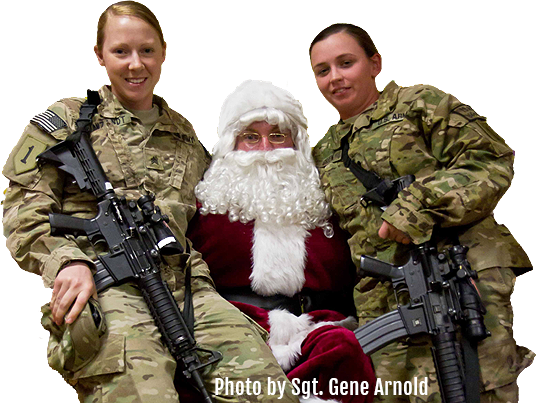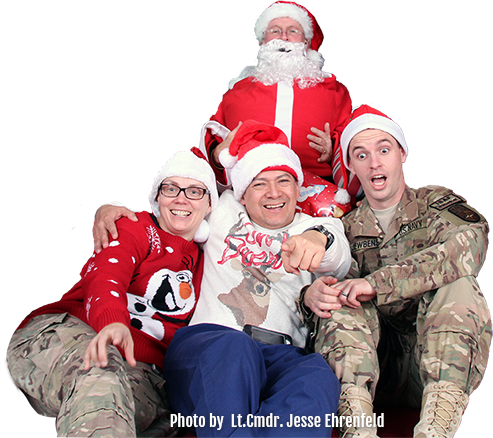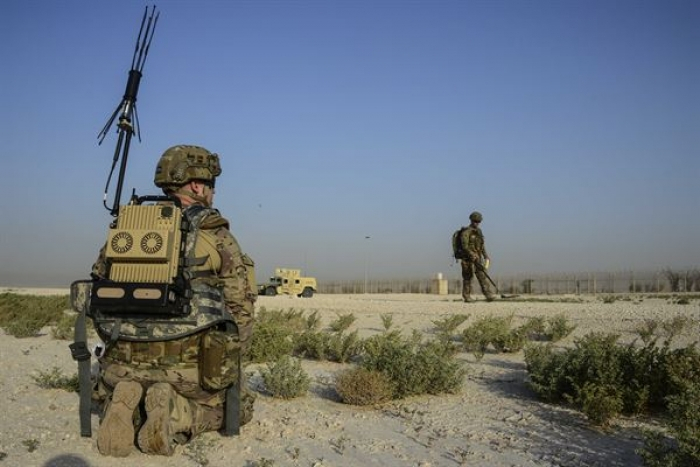 Air Force Tech. Sgt. David Dickey, a 379th Expeditionary Civil Engineer Squadron explosive ordnance disposal craftsman, stays on standby while Tech. Sgt. Kelly Badger, 379th ECES craftsman, sweeps for simulated improvised explosive devices during a training exercise May 19, 2016, at Al Udeid Air Base, Qatar. Air Force photo by Senior Airman Janelle PatinoA week earlier, the family attended the funeral of Badger’s supervisor, Tech. Sgt. Daniel Douville, an EOD flight team leader. Douville and Badger previously deployed together in 2010.
Air Force Tech. Sgt. David Dickey, a 379th Expeditionary Civil Engineer Squadron explosive ordnance disposal craftsman, stays on standby while Tech. Sgt. Kelly Badger, 379th ECES craftsman, sweeps for simulated improvised explosive devices during a training exercise May 19, 2016, at Al Udeid Air Base, Qatar. Air Force photo by Senior Airman Janelle PatinoA week earlier, the family attended the funeral of Badger’s supervisor, Tech. Sgt. Daniel Douville, an EOD flight team leader. Douville and Badger previously deployed together in 2010.
Douville died June 26, 2011, when an improvised explosive device detonated as he was operating on it in a village of Afghanistan’s Helmand province. Douville’s team was part of a joint coalition under the United Kingdom’s Operation Brimstone.
“I remember my oldest son, Tristan, crying and telling me he doesn’t want the bad guys to get me after we had left my supervisor’s funeral,” Badger recalled. “That moment broke my heart, but I have to be strong for them.”
Badger kneeled before Tristan that night in their hotel room, both of them knowing he would leave for Afghanistan again the next day. Badger watched as his son struggled beneath the weight of his tactical vest and helmet. The boy also struggled to hold back his tears.
Service as a Calling
In that vulnerable moment with his son in the wake of the loss of a fellow EOD wingman, Badger knew he had to reassure his family of his training and determination.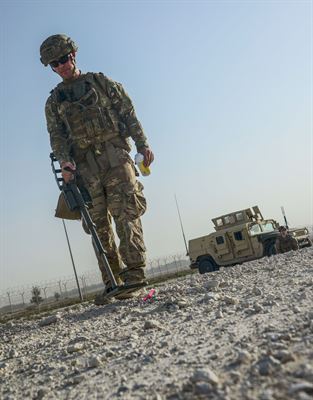 Air Force Tech. Sgt. Kelly Badger, a 379th Expeditionary Civil Engineer Squadron explosive ordnance disposal craftsman, uses a compact metal detector to interrogate an improvised explosive device he detected during a training exercise May 19, 2016, at Al Udeid Air Base, Qatar. Air Force photo by Senior Airman Janelle Patino
Air Force Tech. Sgt. Kelly Badger, a 379th Expeditionary Civil Engineer Squadron explosive ordnance disposal craftsman, uses a compact metal detector to interrogate an improvised explosive device he detected during a training exercise May 19, 2016, at Al Udeid Air Base, Qatar. Air Force photo by Senior Airman Janelle Patino
“I assured him that I’m a fighter, and I won’t let the bad guys get their dad,” Badger said. “My gear would keep me safe.”
For Badger, joining the EOD flight was his calling. His focus and drive was to fight for his country, especially after the events of 9/11.
“I wanted to fight for our country. I chose EOD because I wanted to keep our brothers and sisters in the service from getting killed by IEDs,” Badger said. “I chose to save lives even if it meant putting my own at risk.”
The drive to serve runs deep in Badger’s family. His brother, retired Air Force Staff Sgt. Mark Badger, was also an EOD technician. He is credited with eliminating more than 60 IEDs in 2010 during a deployment to Afghanistan before he was injured in an explosion while providing counter-IED support to an Army cavalry unit.
EOD Mission
EOD airmen are trained to detect, disarm, detonate and dispose of explosive threats all over the world. They are assigned to some of the most dangerous missions where they tactically perform harrowing and demanding tasks in diverse environments.
The EOD flight at Al Udeid Air Base supports the base by being trained and ready to respond to any emergency dealing with unexploded ordnance, aircraft crashes, IED threats or suspicious packages. EOD also works alongside and supports the Joint Special Operations Task Force mission by partnering with host-nation EOD units, to include the Qatari Internal Security Forces. The EOD flight also trains with joint service EOD units that are deployed to other locations throughout the U.S. Central Command’s area of responsibility.
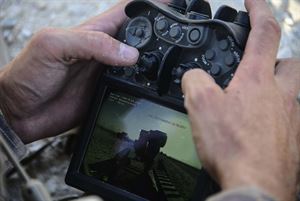 Air Force Staff Sgt. Darrel Linkus, a 379th Expeditionary Civil Engineer Squadron explosive ordnance disposal craftsman, directs a PacBot 310 robot toward a simulated improvised explosive device during a training exercise, May 19, 2016, at Al Udeid Air Base, Qatar. Air Force photo by Senior Airman Janelle Patino Although the deployed EOD mission is different compared to its stateside mission, airmen still deal with training. However, Badger points out, training here is more realistic due to equipment availability and natural environmental situations, such as the hot desert weather.
Air Force Staff Sgt. Darrel Linkus, a 379th Expeditionary Civil Engineer Squadron explosive ordnance disposal craftsman, directs a PacBot 310 robot toward a simulated improvised explosive device during a training exercise, May 19, 2016, at Al Udeid Air Base, Qatar. Air Force photo by Senior Airman Janelle Patino Although the deployed EOD mission is different compared to its stateside mission, airmen still deal with training. However, Badger points out, training here is more realistic due to equipment availability and natural environmental situations, such as the hot desert weather.
“If we aren’t dealing with real-life incidents, we are training,” he said. “We get as much training with as many different situations as we can to gear up for future incidents, even if it means flying out to different locations throughout the region.”
The need for constant, diverse training is critical. Badger reflected on one late-night call in Afghanistan. His team spent more than six freezing hours in an underground tunnel system after wading through waist-deep snowmelt to clear out an IED that was powerful enough to destroy a vehicle and swallow it in a hole 30 feet deep.
He credited proper training with helping him and his wingman and successfully clear the IED and save lives, even as they risked their own lives facing both the explosive device and hypothermia.
Families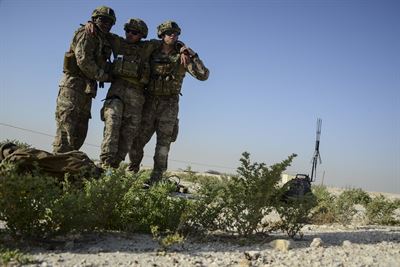
Badger said he is grateful for and inspired by the strength of his family.
“Because I’m gone most of the time, I have missed special moments such as childbirths, birthdays and anniversaries,” he said. “But I am grateful, and I salute my wife for being strong and for taking care of business while I’m gone. She is a great military spouse.”Air Force Master Sgt. Thomas Dennis, 379th Expeditionary Civil Engineer Squadron first sergeant, and Tech. Sgt. David Dickey, 379th ECES explosive ordnance disposal craftsman, escort Staff Sgt. Darrel Linkus, also a 379th ECES EOD craftsman, to a simulated medical evacuation helicopter during a training exercise, May 19, 2016, at Al Udeid Air Base, Qatar. Air Force photo by Senior Airman Janelle Patino
For Badger, he continues to do what he does not only for his immediate family, but also for his military family.
“I do my job for my family back home and the airmen whom I serve with side-by-side, every day of my life,” he said. “The more I can help, train and share what I have learned throughout the years, the better and safer they will be, especially when they get called upon to go to combat.”
Written June 07, 2016 by By Air Force Senior Airman Janelle Patino 379th Air Expeditionary Wing Public Affairs. Republished and redistributed by permission of DoD.




